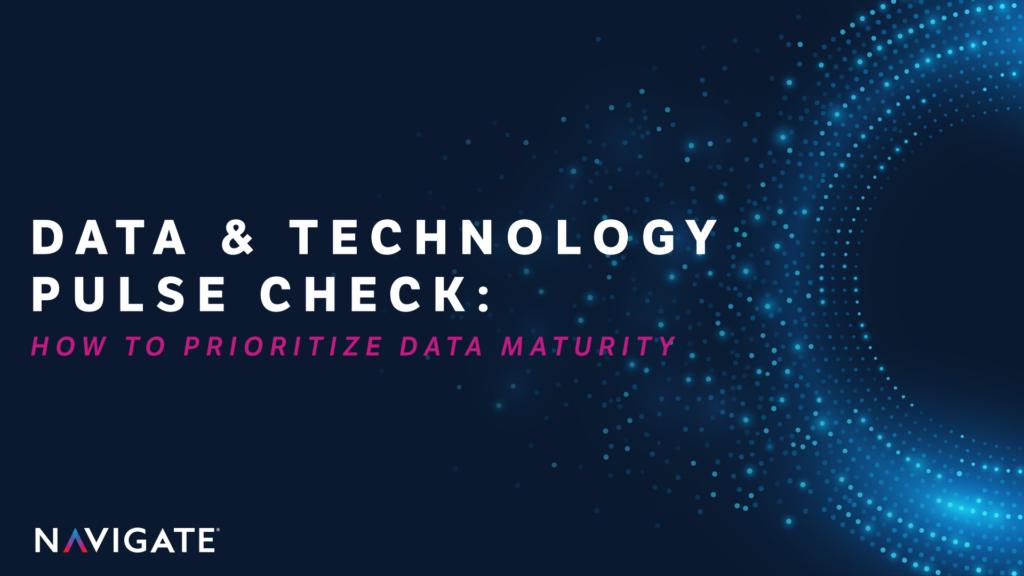
Data & Technology Pulse Check: How to Prioritize Data Maturity
Why It’s Important
Data and analytics are the central underpinning of any business, especially in the fan-centric world of sports and entertainment. When a business is data mature, it can increase productivity and make data-driven decisions to exceed business goals. It is critical for teams and properties to understand their business at the deepest levels. The business of knowing their fans, the business of increasing ticket sales or partnership revenue, and business of engaging new fans all across the globe. Navigate works with several clients to help them build best-in-class data solutions and overcome business intelligence hurdles. However, in addition to seeking outside counsel, it’s also important for those within an organization to regularly take a step back and evaluate their data maturity, but what does that actually mean?
Step 1: Understanding the Data Maturity Timeline – What is it and Where are you on the Timeline?

Navigate defines data maturity as an organization’s level of readiness and capability in effectively utilizing data to drive decision-making, achieve strategic goals, and generate meaningful insights. It represents the progression and evolution of an organization’s data-related practices, processes, and infrastructure over time.
In simple terms, it’s an organization’s ability to utilize data and analytics for major business decisions – naming rights insights, single game ticket pricing, and customer-driven marketing campaigns to name a few.
An organization should be able to place themselves on a data maturity timeline, as illustrated above. There are several questions a team should ask of itself to get an indication of where they are on the data maturity timeline, including:
- What is our current level of data literacy and awareness as an organization?
- How well-defined and structured is our data governance framework?
- What is the extent and quality of our data infrastructure?
- How effectively are we utilizing data analytics to drive insights and decision-making?
- How strong is our data-driven culture and talent pool?
Answering these questions can give clues to the team’s culture of data and serve as the foundation for informed decision-making and longer-term success. Then, these properties can strategically leverage the data they have (or the data they need) to gain valuable insights and execute business decisions that will position them for success.
To help show a different point of view – we reached out to Josh Mangus. Josh, a friend of Navigate, is a seasoned technology advisor with a specialty in data analytics. He has solved data-centric challenges for private and public sector enterprises at all levels, and shares with us his key takeaways as they apply to the sports industry.

Step 2: Determine Your Data Needs
It should be your organization’s goal to source and cultivate high-quality data, and move it down the funnel so that it can be leveraged in the most impactful revenue driving decisions.

When determining how to progress along the data maturity timeline, it is important to block out the noise of the market and focus on your team’s specific data needs. Identifying the right, high-quality data is one of the most important steps in the process.
Once you clarify your needs and separate the theoretical from the practical, you can begin bolstering your team’s capabilities with data and analytics. It begins with an understanding of key decision points on the data maturity timeline and the questions your team will need to answer.
A few questions to help your teams explore this might include:
- What standard KPI’s do our business stakeholders need access to deliver impact?
- Where will the data come from and how we will be able to utilize it?
- How can we ensure data cleanliness & quality?
- What type of analytics best apply to these data sources?
- What kind of software and tools will help us achieve our business goals?
- Who are the final users of the results and how will the analysis be used?

Step 3: Build It or Buy It – How to Start Your Data Journey
Now that you’ve acknowledged the need to build data into your organization’s decision-making, you will also identify the gaps in the technology stack that are preventing you from getting there – enter one of the most common questions teams face:
When looking for new technology and systems to manage and grow your business do you build it yourself, buy it from a vendor, or combine both?
Regardless of industry, it’s a question that often plagues organizations as they look to ensure they are leveraging the next breakthrough technology. Approaching this topic without a purpose and proper planning can quickly turn an opportunity into a lose-lose situation.
There’s never a perfect answer to the question and the answer will always depend on your business’ unique context. Below are a few considerations that might help you for when the build vs. buy question arises next time.
- How quickly do you need to grow?
- What skills are you missing?
- Think about the total cost of ownership
- How unique is your business?
- How good is your project management?
- Does “off the shelf” fit your needs?

Each organization will have a different perspective based on their needs and goals. Once your team has worked through this step in the data maturity model, you’ll quickly improve in your ability to utilize your newly aligned (or revamped) data and technology.
Step 4: Enhance or Advance Your Data Capabilities
At this point in the journey, the right solution can either be used to enhance a team’s practices in their current state or advance their practices to a future state.
The last step in the data maturity model is the willingness to experiment with new trends and technologies. Experimentation in its full form is most effective when the other steps have been met and a team can be a true early adopter of new technology because they have a foundation of tools aligned to their business needs.
A great example of this in the market is generative AI and the new frontier introduced by large language models like ChatGPT. While AI will usher in a new age of technology, productivity, and innovation, none of those things can be achieved if there is a disconnect in the team’s current tech stack or fan engagement tools.

This is why experimentation is the last step in advancing along the data maturity model rather than the first. In experimentation, failing is expected, but teams that have nothing to fall back on after failures tend to fall much further than those who have a solid understanding of why they are experimenting.
Closing Thoughts
Moving your organization to a higher point on the data maturity timeline is an arduous task. It takes time, buy-in from leadership, advocacy from users, and often investment in the form of a commitment to change the way the team does business, but that alignment is crucial for any team seeking a new level of operating superiority..
If you have any questions, or would like to learn more about how Navigate has been working with our clients on this decision-making process and ensuring they are maximizing their data processes from start to finish, feel free to email Greg Krug at Greg@NVGT.com.
 Greg Krug is Senior Director, Client Strategy at Navigate. He is currently leading a range of client-facing initiatives, blending the art and science of data to provide strategic recommendations to professional teams, leagues, and brands across sports and entertainment. Committed to driving success through analytics-based decision-making, his focuses commonly include overall business strategy, revenue generation, and customer activation. His portfolio of work to date spans across teams at all of the major leagues, supporting revenue and fan growth strategies within ticketing, premium sales, marketing, and sponsorship. He is also energized by tracking emerging technologies and enjoys guiding clients’ data and technology strategy as it relates to the capture and utilization of data.
Greg Krug is Senior Director, Client Strategy at Navigate. He is currently leading a range of client-facing initiatives, blending the art and science of data to provide strategic recommendations to professional teams, leagues, and brands across sports and entertainment. Committed to driving success through analytics-based decision-making, his focuses commonly include overall business strategy, revenue generation, and customer activation. His portfolio of work to date spans across teams at all of the major leagues, supporting revenue and fan growth strategies within ticketing, premium sales, marketing, and sponsorship. He is also energized by tracking emerging technologies and enjoys guiding clients’ data and technology strategy as it relates to the capture and utilization of data.

Josh Mangus is a data management consultant with over a decade of experience in data architecture, governance, and visualization and holds professional certifications in data analysis and stewardship. He has engaged with clients both in the public and private sector, helping his clients get the most out of their data by designing great products and translating technical concepts into clear and achievable business goals. Josh’s work has been recognized by organizations such as the American Council for Technology & Industry Advisory and has earned him accolades for his innovative approaches and problem-solving skills.







